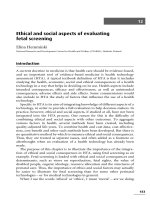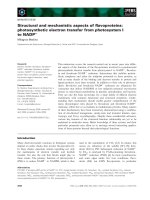CLINICAL AND GENETIC ASPECTS OF EPILEPSY doc
Bạn đang xem bản rút gọn của tài liệu. Xem và tải ngay bản đầy đủ của tài liệu tại đây (10.63 MB, 214 trang )
CLINICAL AND GENETIC
ASPECTS OF EPILEPSY
Edited by Zaid Afawi
Clinical and Genetic Aspects of Epilepsy
Edited by Zaid Afawi
Published by InTech
Janeza Trdine 9, 51000 Rijeka, Croatia
Copyright © 2011 InTech
All chapters are Open Access articles distributed under the Creative Commons
Non Commercial Share Alike Attribution 3.0 license, which permits to copy,
distribute, transmit, and adapt the work in any medium, so long as the original
work is properly cited. After this work has been published by InTech, authors
have the right to republish it, in whole or part, in any publication of which they
are the author, and to make other personal use of the work. Any republication,
referencing or personal use of the work must explicitly identify the original source.
Statements and opinions expressed in the chapters are these of the individual contributors
and not necessarily those of the editors or publisher. No responsibility is accepted
for the accuracy of information contained in the published articles. The publisher
assumes no responsibility for any damage or injury to persons or property arising out
of the use of any materials, instructions, methods or ideas contained in the book.
Publishing Process Manager Dragana Manestar
Technical Editor Teodora Smiljanic
Cover Designer Jan Hyrat
Image Copyright yalayama, 2011. Used under license from Shutterstock.com
First published August, 2011
Printed in Croatia
A free online edition of this book is available at www.intechopen.com
Additional hard copies can be obtained from
Clinical and Genetic Aspects of Epilepsy, Edited by Zaid Afawi
p. cm.
ISBN 978-953-307-700-0
free online editions of InTech
Books and Journals can be found at
www.intechopen.com
Contents
Preface IX
Part 1 Mechanisms Underlying Epileptic Seizures 1
Chapter 1 A Functional Role for Microglia in Epilepsy 3
Martine M. Mirrione
and Stella E. Tsirka
Chapter 2 The Blood-Brain Barrier in Epilepsy 23
Björn Bauer, Juli Schlichtiger, Anton Pekcec
and Anika M.S. Hartz
Chapter 3 New Tools for Understanding Epilepsy 55
Fatima Shad Kaneez and Faisal Khan
Chapter 4 Epilepsy: Selenium and Aging 75
Caroline Rocourt, Ying Yu
and Wen-Hsing Cheng
Part 2 Molecular Genetics of Epilepsy 93
Chapter 5 The Molecular Genetics of the
Benign Epilepsies of Infancy 95
Sarah E. Heron and John C. Mulley
Part 3 Animal Models 113
Chapter 6 Audiogenic Seizures - Biological Phenomenon
and Experimental Model of Human Epilepsies 115
Inga I. Poletaeva, Irina B. Fedotova, Natalia M. Sourina
and Zoya A. Kostina
Part 4 Ion and Channels 149
Chapter 7 Ionic Imbalance 151
John Robert Cressman, Christine Drown
and Monica Gertz
VI Contents
Part 5 New Treatments 173
Chapter 8 Antiepileptic Medicinal Plants
used in Traditional Medicine to Treat Epilepsy 175
E. Ngo Bum, G.S. Taiwe, F.C.O. Moto, G.T. Ngoupaye,
R.R.N. Vougat, V.D. Sakoue, C. Gwa, E.R. Ayissi, C. Dong,
A. Rakotonirina and S.V. Rakotonirina
Chapter 9 The Potential Role of ATP-sensitive Potassium
Channels in Treating Epileptic Disorders 193
Chin-Wei Huang
Preface
This book on Epilepsy was conceived and produced as a source of information on
wide range of issues in epilepsy. We hope that it will help health care providers in
daily practices and increase their understanding on diagnosis and treatment of
epilepsies.
The book was designed as an update for neuroscientists who are interested in
epilepsy, primary care physicians and students in health care professions.
This epilepsy book is the result of a collaborative effort of investigators who have used
a wide range of experimental preparations and recording techniques. Authors from a
variety of backgrounds have contributed significantly with papers from their
respective fields. I believe they have provided a comprehensive description of key
issues and important developments within each filed of research.
The studies included in this book are drawn from several disciplines of modern
neuroscience and include various Chapters distributed in sections on Mechanisms
Underlying Epileptic Seizures, Molecular Genetics of Epilepsy, Animal Models, Ion
and Channels and New Treatments
Zaid Afawi
Tel-Aviv Medical Center
Tel-Aviv,
Israel
Part 1
Mechanisms Underlying
Epileptic Seizures
1
A Functional Role for Microglia in Epilepsy
Martine M. Mirrione
1,2,3
and Stella E. Tsirka
1
1
Department of Pharmacological Sciences, Molecular and Cellular Pharmacology, Stony
Brook University, Stony Brook, New York
2
Medical Department, Brookhaven National Laboratory, Upton, New York
3
Cold Spring Harbor Laboratory, Cold Spring Harbor, New York
USA
1. Introduction
Microglia are the immune competent cells of the CNS and comprise the major mechanism of
self-defense against brain injury, infections and disease. Activation of microglia occur as a
response to these insults, and both neurotoxic and neuroprotective factors can be released
(Streit et al., 1999, Streit, 2002, Schwartz, 2003, Schwartz et al., 2006). There is a great deal of
evidence suggesting that microglia have a role in neurodegenerative diseases, either to
promote the pathology, or to counter it. However in the case of epilepsy, specific questions
still remain including how, why, and when microglia are activated. In this first section, we
will provide a general introduction to the role of activated microglia in the central nervous
system (CNS). In subsequent sections, we will specifically discuss evidence of a functional
role for microglia in epilepsy.
In the normal brain, the majority of microglia are in the resting, or quiescent ramified state.
This shape with their long processes, allows them to quickly assess and respond to CNS
injury or pathogens. During excitotoxic insult or inflammation, microglia become activated.
This activation is manifested morphologically by retraction of their processes and changing
to a rounded amoeboid morphology. Microglia also become proliferative and migratory.
Their electrophysiological characteristics are altered and the expression of potassium,
proton, sodium, calcium and chloride currents changes (Eder, 1998, Ducharme et al., 2007,
Averaimo et al., 2010, Skaper, 2011). Once activated, the primary function of microglia is to
return injured tissue to homeostasis (Streit and Xue, 2009), but this is a double edged sword,
as their presence can be both ‘good’ and ‘bad’ for neurons. These effects are complex and
overlapping, and not necessarily mutually exclusive.
In an effort to protect surviving cells during pathological conditions, microglia have been
shown to ‘execute’ damaged or dying neurons injured from excitotoxicity in order to protect
nearby cells from lytic release of toxic intracellular contents. Thus, microglia will facilitate
local tissue repair by phagocytosing these cells and cell debris. This occurs through initial
mobilization of cells near the site of injury and recruitment of distant microglia into the
damaged area, which release proinflammatory mediators. At appropriately minimal and
transient microglial activation, this process is ultimately neuroprotective (Vilhardt, 2005).
However unregulated hyperactivation and release of toxic factors, such as nitric oxide (NO),
Clinical and Genetic Aspects of Epilepsy
4
leading to over production of excess peroxynitrite, and reactive oxygen and nitrogen species
(ROS, RNS), may result in an unmanageable level of oxidative stress causing degeneration
in nearby ‘bystander’ cells. Oxidative stress can cause further neuroinflammation as well by
recruitment of peripheral immune cells into the damaged brain. This could occur through a
compromised blood-brain-barrier (BBB) as can be the case in stroke, Alzheimer’s disease,
amyotropic lateral sclerosis, and epilepsy (del Zoppo et al., 2000, Mhatre et al., 2004, van
Vliet et al., 2007).
Microglia can also be modulatory by secreting a host of inflammatory mediators upon
activation, including cycloxygenase-2 (Cox-2), interleukin-3 (Il-3), interleukin-6 (Il-6),
interleukin-1beta (IL-1β), tumor necrosis factor-alpha (TNF-α), prostaglandins (PGs), tissue
plasminogen activator (tPA), monocyte chemoattractant protein-1 (MCP-1), vascular
endothelial growth factor (VEGF), lymph toxin, matrix metalloproteinases (MMPs), and
macrophage inflammatory protein-1alpha (MIP-1α). The identity, quantity and duration of
release of these factors can vary widely based on the specific injury. Some of these
molecules can be toxic in high amounts, and certainly can have a direct impact on neuronal
function. For example, we have studied the protease tissue plasminogen activator (tPA),
which along with other trophic factors released by microglia, has been demonstrated to be
critical in the sprouting of mossy fibers emanating from the dentate gyrus (DG) (Wu et al.,
2000, Ferrer, 2002, Zhang et al., 2004) and may potentially facilitate seizure recruitment and
the chronic maintenance of convulsions (Sloviter et al., 1996, Buckmaster et al., 2002, Shibley
and Smith, 2002, Winokur et al., 2004). Indeed a number of studies including our own, have
suggested that tPA from neurons, and potentially also microglia, plays a role in mediating
seizure development (Qian et al., 1993, Schmoll et al., 2003, Yepes and Lawrence, 2004,
Pawlak et al., 2005, Mirrione et al., 2007).
There is as well, a good side to this double-edged ‘microglia’ sword. They can also release
several neuroprotective factors, such as neurotrophins including brain-derived neurotrophic
factor (BDNF) and nerve growth factor (NGF), which can in fact promote neuronal stability
(Elkabes et al., 1996, Miwa et al., 1997, Elkabes et al., 1998, Heese et al., 1998, Nakajima et al.,
2001a). Maximizing this neuroprotective function can become particularly important in the
aging brain as microglia cells enter a phase of senescence, and aged neurons require greater
neuroprotection (Streit et al., 2008). Microglia can also positively influence pathological
conditions by facilitating the recovery of injured neurons through release of trophic factors
as well as extracellular matrix molecules, such as thrombospondin, important for sustaining
neuronal function (Chamak et al., 1994). Additionally, application of microglia to the site of
spinal cord injury has been shown to improve regenerative neurite outgrowth (Rabchevsky
and Streit, 1997).
During CNS injury and glutamate excitotoxicity, microglia can act as both antigen
presenting cells (Neumann et al., 1996, O'Keefe et al., 2001), and as cells that can remove
harmful materials, including glutamate. Activated microglia express the high affinity
glutamate transporter GLT-1, and thus can contribute approximately 10% of glutamate
recycling (Nakajima et al., 2001b, Shaked et al., 2005, Persson et al., 2006), which may
become more important under pathological conditions especially if astrocytes are
overburdened or impaired. In addition, the cerebellum bergman glia have been shown to be
involved in tonic GABA release through the ion channel Best1 (Lee et al., 2010), which may
also be expressed and function in microglia in other brain regions (Ducharme et al., 2007).
A Functional Role for Microglia in Epilepsy
5
While this remains to be explored, tonic GABA release could also be a mechanism for
microglia to modulate seizures.
Other ways in which microglia may be beneficial involves the emerging notion of protective
autoimmunity (Shaked et al., 2005). During CNS injury such as glutamate toxicity, a
proposed mechanism to minimize the destruction would involve building a tolerance to
autoimmune self-antigens, and could involve priming or preconditioning of microglia cells
(Schwartz et al., 2003). This may be accomplished in several ways, but one experimental
way is to expose microglia to lipopolysaccharide (LPS) prior to the injury or pathology.
There are a few examples in the literature where preconditioning microglia with LPS
modulates seizures including our own, and this will be discussed in more detail in the next
section (Sayyah et al., 2003, Akarsu et al., 2006, Arican et al., 2006, Dmowska et al., 2010,
Mirrione et al., 2010, Yang et al., 2010a). One mechanism that may contribute to the positive
effects attributed to LPS preconditioning is through enhanced neurotrophin release
(Nakajima et al., 2001a). While activated rat microglia have indeed been shown to release
BNDF, this release is significantly enhanced when they are stimulated with LPS.
Furthermore, these activated microglia also released NGF, suggesting that in the context of
LPS preconditioning, microglia could be neuroprotective through release of neurotrophins.
A careful balance needs to be maintained in dosage and timing of LPS application, as of
course it also activates release of potentially toxic factors. Therefore, new strategies to
precondition microglia in more refined ways to promote neuroprotective functions, and
minimize neurotoxic factor release, may prove to be therapeutically beneficial. In fact one
study showed that application of ceramide increased the release of protective factors, but
not other potentially dangerous molecules, through specific signaling mechanisms involving
protein kinase C (PKC) (Nakajima et al., 2002). As well, interferon-gamma (INF-gamma)
administration causes microglia to significantly increase their ability to remove glutamate,
also without causing an inflammatory response (Shaked et al., 2005). These strategies
should be explored further in the context of seizures and potentially exploited as
neuroprotective modulators.
2. A functional role for microglia in seizures: The ‘bad’ and the ‘good’
A growing body of evidence suggests that microglia have a functional role in the pathology
and symptoms of CNS diseases including ischemia and Alzheimer’s disease. In this section,
we discuss the evidence linking microglia to seizures and epilepsy. We will focus on examples
from the literature suggesting both ‘bad’ neurotoxic, and ‘good’ neuroprotective,
contributions. However, while it is clear from these data that a functional role for microglia
exists, these effects are certainly complex and even contradictory in different literature reports.
Are microglia activated concurrent with seizure pathology, and if so what is the timing,
duration, location and extent of this activation? There is growing evidence suggesting that
yes, extensive microglial activation known as ‘microgliosis’ occurs in the brain parenchama
of patients with recurrent seizure episodes (as well as reactive astrogliosis), and in animal
models of epilepsy particularly in the hippocampus (Beach et al., 1995, Drage et al., 2002).
Activated microglia are observed in the same hippocampal regions associated with seizure
induced neuronal death clinically and in animal models, owing them a reputation for
facilitating neuronal malfunction (Beach et al., 1995, Taniwaki et al., 1996, Tooyama et al.,
2002, Borges et al., 2003). In patients, microglia activation was found in the sclerotic
hippocampus, suggesting that neuronal degeneration continues to occur as a result of
Clinical and Genetic Aspects of Epilepsy
6
ongoing seizure activity (Beach et al., 1995). A recent study confirmed the presence both of
activated microglial and also immunoreactive leukocytes in tissue resected from patents
with intractable medial temporal lobe epilepsy, and in kainic acid (KA) treated mice, either
associated with blood vessels or distributed intraparenchymally in the CA1-CA3, hillus, and
to a lesser extent, dentate gyrus (Zattoni et al., 2011). Following pilocarpine induced
seizures in mice, microgliosis persists for at least 3-31 days in regions of neuronal loss such
as the hippocampus and amygdala (Borges et al., 2003, Yang et al., 2010a). However, we
have shown that during KA excitotoxicity, microglia activation is associated with tPA
release from injured neurons, and thus is a consequence rather than a cause of
neurodegeneration, but overall this microglia activation can further exacerbate the injury
(Siao et al., 2003). Gliomas have also been associated with epilepsy, and histological
examination of patients’ tissue following surgical removal has demonstrated that the
numbers of activated microglia correlated with the duration of epilepsy, as well as with the
frequency of seizures prior to surgical resection (Aronica et al., 2005). Overall, this evidence
would suggest that microglia activation is ‘bad’ for the epileptic brain and is associated with
neurodegenerative pathology.
Knowing that microgial activation is associated with seizures and epilepsy is the first step,
but what exactly are these cells doing? Given the plethora of molecules microglia release,
one can easily imagine numerous potential outcomes. For instance, it has been proposed
that microglia activation may contribute to spontaneous recurrent seizures (SRS) by
facilitating aberrant migration of newborn neurons in the DG (Yang et al., 2010a). This
study showed that LPS injected directly into the DG promoted the development of ectopic
hilar basal dendrites in the hippocampus, while addition of minocycline that blocked
microglia activation, prevented it. Neurotrophin and cytokine release can contribute to this
aberrant granule cell neurogenesis (Scharfman, 2005). The expression of pro-inflammatory
transcripts changes after pilocarpine-induced seizures in mice, and includes upregulation of
toll-like receptor type 2 (TLR2, a microglia/macrophage marker) and I kappa B alpha (IB,
index of NF–kappa B activation), particularly in areas undergoing neurodenegeration or
demyelination (Turrin and Rivest, 2004). Increased microglial activation is also found in
adult animals given KA when they have already been exposed to it during adolescence
(Somera-Molina et al., 2009). In this model, early-life seizures created an increased
susceptibility to seizures later in life (‘two-hit seizure’ model), when KA is given at postnatal
day 5 (P5), and then again at P45. The expression of proinflammatory cytokines IL-1 beta,
TNF-alpha, S100B, and the chemokine CCL2 was found to be enhanced, corresponding to
increased susceptibility to seizures in the adults.
Recent evidence strengthens a strong implication of cytokine involvement in modulating
acute seizures. mRNA expression of TNF-alpha and IL-6 correlated with seizure
development in a viral infection model, and knockout mice lacking the receptors for these
cytokines showed reduced seizure frequency (Kirkman et al., 2010). These results suggest
the innate immune response to viral infection contributes to seizures through cytokine
expression, and can potentially occur through modulation of glutamate
receptors/transporters on astrocytes. Such modulation can eventually lead to excessive
extrasynaptic/extracellular glutamate levels, which could also be detrimental (Choi and
Koh, 2008). Another study supports the role of cytokines showing that in brain regions
associated with seizure damage from the nerve agent soman, there was an increased
production of IL-1alpha and IL-1beta (neurotoxic cytokines by activated microglia) as well
as IL-6 (neuroprotective factor released from neurons and astrocytes) at 72 hrs, in the
A Functional Role for Microglia in Epilepsy
7
piriform cortex, hippocampus, and thalamus (Johnson and Kan, 2010). However in this
same model, neurotoxic COX-2 expression, which mediates the production of
prostaglandins, was found expressed in neurons, but not in microglia or astrocytes (Angoa-
Perez et al., 2010). In the mouse kindling model, COX-1 from microglia was enhanced in the
hippocampus during progression of seizures and the administration of SC-560 (a selective
COX-1 inhibitor) or indomethacine (a non-selective COX inhibitor) reduced the progress of
seizures (Tanaka et al., 2009). These two studies suggest that in addition to cytokines,
cyclooxygenase enzymes derived from neurons and microglia may also play an important
role in mediating seizures.
In terms of electrophysiological changes, one study showed that the cortical innate immune
response to LPS application actually increased local neuronal excitability. Furthermore, in a
subset of animals, this also produced motor seizures (Rodgers et al., 2009). Based on their
experimental evidence, the authors suggest that microglial activation may therefore be a
potential precursor to seizures, and not a consequence of them. Specifically, they showed
that when LPS is applied to the cortex in vivo, the evoked field potential amplitudes were
acutely enhanced (as measured within 5min-1hr) and produced focal epileptiform
discharges, which were prevented by pre-application of an interlukin-1 receptor antagonist.
They suggested that this rapid response may result in increased glutamate and
noradrenaline release within 10 min, potentially causing the rapid increases of neuronal
excitability (Wang and White, 1999). While this study showed that LPS induced microglial
activation produces increases in neuronal excitability, they only measured short time points,
and so further experiments are necessary to determine whether this effect is long lasting and
can truly facilitate seizure symptoms.
Although the aforementioned data suggest a strict neurotoxic role of microglia, it must be
kept in mind however, that this activation is a response to ongoing injury and abnormal
circuitry rewiring. Little affirmative evidence is available suggesting that microglia are
causing neuronal malfunction directly (with the exception of the acute study by Rogers et.
al. described above) especially since this evidence comes from rodent models where
chemoconvulsants are typically used to trigger the symptoms. Therefore it is important to
establish whether microgliosis is a consequence of recurrent seizure episodes or a direct
early contributor to symptoms. This is inherently complex however, based on their multiple
functions as described in the first section.
The most obvious way to probe these questions is to pharmacologically activate and inhibit
microglial activation before, during, and after experimental seizure induction and monitor
differences in acute seizure symptoms and pathology. Another way to study this is to
examine seizures in knockout mice missing integral components of the inflammatory
response. Zattoni et al (Zattoni et al., 2011) showed that selective pharmacological ablation
of peripheral macrophages prior to kainate injection actually increased dentate granule cell
degeneration. This result suggested that the F4/80 (microglia/macrophage marker) positive
cells, specifically of peripheral origin, appear to be required for long-term survival of
granule cells. The same investigators also showed enhanced neurodegeneration in mutant
mice lacking B or T cells, also suggesting a strong impact of immune-mediated responses on
network excitability. Overall, these findings support the idea that lymphocytes and
macrophages infiltrating the epileptic focal area may have a neuroprotective role.
Several other groups including ours have used LPS to activate microglia at different time
points prior to seizures. An interesting result that may be counterintuitive given all the
studies described above, is that preconditioning microglia before seizures has shown to be
Clinical and Genetic Aspects of Epilepsy
8
potentially protective. This is akin to reports that sublethal stress stimuli induce tolerance in
ischemia (Marsh et al., 2009). In one study, LPS administration prior to pentylenetetrazole
(PTZ)-induced seizures was beneficial by increasing plasma levels of NO and IL-6, which
reduced blood brain barrier permeability (Arican et al., 2006). In kindling, LPS was
inhibitory but only when it was administered daily for 16 days, as it blunted the acquisition
of kindled behavioral seizures (Sayyah et al., 2003). Neuronal protection from cell death in
hippocampal CA1, CA3 and DG was observed with LPS preconditioning 72 hours prior to
seizure induction, although seizure behavior was not affected at this low dose of LPS
(Dmowska et al., 2010). Importantly, one study addressed the time course of LPS delivery
prior to seizure induction and demonstrated complex effects (Akarsu et al., 2006). This
group showed that LPS given 4 hr before PTZ-induced seizures was pro-epileptic, but when
given 18 hr before, it conferred anticonvulsant effects attributable to the expression of COX-
1 and -2. It is possible that LPS stimulated release of cytokines concurrent with PTZ drives
the pro-convulsant effect, but how protection is conferred by delaying seizure induction for
hours to days after LPS administration is less obvious. Tolerance to excitatory input,
depletion of intracellular stores of proinflammatory mediators, and upregulation of
glutamate recycling in anticipation of the next insult, are all plausible explanations which
need further study.
Important questions that remain include what are the circumstances that cause microglia
activation during seizures specifically, and are microglia strictly necessary for seizure
development? We were surprised recently in studying these questions to find that the
activation state of microglia in the hippocampus has a direct impact on the sensitivity of
acutely induced seizures. In our experiment, we asked whether conditional
microglia/macrophage ablation could affect epileptogenesis using genetically modified
mice (Mirrione et al., 2010). These mice express the herpes simplex virus thymidine kinase
(HSVTK) gene under the CD11b macrophage/microglia promoter (CD11b-HSVTK+/-). As
shown in the schematic of Figure 1a, activated microglia are present throughout
hippocampal subfields associated with seizures. Ganciclovir (GCV) is administered intra-
hippocampally through an implanted osmotic mini-pump. Over time, GCV can be taken up
by cells in the hippocampus near the infusion site, which extends throughout the ipsilateral
hippocampus. Subsequently, LPS and pilocarpine can be administered i.p. during the
experiment. Figure 1b describes the effect of the HSVTK transgene which is under the
control of the Cd11b promoter, and thus expressed exclusively in microglia and
macrophages. Cd11b is expressed in resting, ramified microglial cells at low baseline levels,
which results in some moderate HSVTK expression. However, cells that are activated (by
LPS or pilocarpine) begin to upregulate Cd11b, and thus will express more of the HSVTK
suicide gene. HSVTK by itself does not harm the cell, similar to GCV, which by itself is
harmless. However, cells that contain both HSVTK and GCV will be susceptible to ablation.
HSVTK will phosphorylate GCV, which is further phosphorylated by intracellular kinases.
This toxic triphosphate then competes with thymine for DNA synthesis, and causes DNA
replication failure killing the cell (Heppner et al., 2005). Therefore, one can selectively target
microglia/macrophages for ablation as the expression of Cd11b is restricted to these cells,
and increased in activated microglia. This drives increased expression of the HSVTK gene,
which causes apoptosis. Microglia/machrophage cells that are in S phase of cellular division
are particularly susceptible to ablation using this method, however non-dividing cells are
also susceptible, albeit at reduced levels, which may be due to interference with
mitochondrial DNA synthesis (Herraiz et al., 2003).
A Functional Role for Microglia in Epilepsy
9
Fig. 1. Microglial ablation and lipopolysaccharide preconditioning modulates pilocarpine-
induced seizures in mice. A) Activated microglia are present in hippocampal subfields
following LPS and/or pilocarpine induced seizures, Neuronal circuitry in the hippocampus
consists of a mainly unidirectional loop of excitatory and inhibitory signals known as the
‘trisynaptic circuit’, although additional connections between subfields also exist. These
neurons are vulnerable to neurodegeneration in seizure models, and DG neurons
specifically undergo circuitry rewiring propagating seizure activity. We have shown that
that the activation state of microglia in the hippocampus can have a direct impact on the
sensitivity of acutely induced seizures. In the experiment, the hippocampus is targeted with
intra-hippocampal infusion of ganciclovir (GCV) through an osmotic mini-pump. LPS and
pilocarpine are given intraperitoneally (i.p.) and seizure symptoms are recorded. B)
Mechanism of cell ablation via GCV and HSVTK. The morphology of resting and activated
microglia are shown. The microglia/machrophage specific integrin protein, Cd11b (the
alpha chain of the Mac-1 integrin), has low expression in resting cells, and is increased in
activated cells. The HSVTK suicide gene is placed under the control of the promotor CD11b.
When microglia are activated, CD11b expression increases and HSVTK is highly expressed.
In a cell which has taken up GCV, and is expressing HSVTK, GCV is phosphorylated by
Clinical and Genetic Aspects of Epilepsy
10
HSVTK and endogenous kinases (phosphorylation represented by red circle’s labeled ‘P’).
This turns GCV into a toxic triphosphate which competes with endogenous thymine for
DNA synthesis. Ultimately, DNA replication is disrupted and the cell undergoes apoptosis.
C) Data showing CD11b-HSVTK-/- (wild type, left) mice compared to CD11b-HSVTK-/-
(transgenic mice, right) under control and LPS preconditioning (CA1 subfield, DAPI (blue)
and Iba1 (green), scale bar 50 µm) conditions. There were significantly fewer Iba1 positive
cells (microglia/macrophages) in the transgenic mice following GCV in both conditions;
however seizure symptoms (right panels) only showed a significant divergence, when LPS
was administered 24 hr before the pilocarpine injection. In this group, seizure scores were
dramatically increased over the first 60 min following pilocarpine injection. Thus in the
absence of LPS activated microglia/macrophages, seizure symptoms were significantly
elevated. Additionally, LPS preconditioning in CD11b-HSVTK-/- (wild type) mice also
showed a trend toward reducing seizure scores. (Part C, adapted and partially reproduced
from (Mirrione et al., 2010)).
Our results showed that unilateral ablation of quiescent (non-activated) microglia from the
dorsal hippocampus did not necessarily alter acute seizure sensitivity (Figure 1 c, top panel),
but ablation of activated microglia (by LPS given 24 hrs prior to pilocarpine) did in fact
significantly enhance seizure symptoms (Figure 1c, bottom panel, and summarized in Table
1). Furthermore, we observed a trend toward reduced seizure activity in LPS preconditioned
mice, similarly to what other groups have reported (Sayyah et al., 2003, Akarsu et al., 2006,
Arican et al., 2006, Dmowska et al., 2010). These data would suggest that LPS activated
microglia were providing some protection to the hippocampus, perhaps by controlling the
spread of seizure activity. Additional studies are required to identify the chemical
mediators released by microglia that may underlie this protective effect, and whether
bilateral microglia/macrophage ablation would be further protective As well, it would be
interesting to further evaluate whether neurodegeneration patterns are altered at chronic
time points. In regards to how LPS activated microglia upregulate Cd11b, one group
showed this was mediated by nitric oxide (NO) (Roy et al., 2006, Roy et al., 2008). Therefore,
LPS may be enhancing inducible nitric-oxide synthase (iNOS) in microglia, which produces
NO, upregulating Cd11b, and concurrently the HSVTK gene. This would increase the
percentage of cells ablated by GCV over time, potentiating the response to pilocarpine
(Table 1). Furthermore, there is evidence as well that ablation of macrophages, and
neutrophils which also express CD11b, may certainly play an important role, and shouldn’t
be discounted as potential mediators (Zattoni et al., 2011). In the future, these transgenic
mice can be extremely useful for in depth examination of conditional
microglial/macrophage ablation in other brain regions such as the amygdala, cortex, or
more specifically targeted subfield regions of the hippocampus.
Table 1. Expression of transgene based on activaction state of microglia.
A Functional Role for Microglia in Epilepsy
11
In our study, we also explored whether changes in glial function were a component of
metabolic changes in these mice following pilocarpine using small animal imaging with 2-
deoxy-2[(
18
)F]fluoro-d-glucose (
18
FDG) and positron emission tomography (PET). Our goal
was to find the brain regions involved in the behavioral divergence we observed in CD11b-
HSVTK+/- mice, compared to wild type mice, using a systems approach. In pilocarpine
treated animals of both genotypes, we found increased
18
FDG uptake during seizures in the
septum, thalamus, hippocampus, midbrain, and cerebellum, along with decreases in the
striatum, which was consistent with our previous findings (Mirrione et al., 2007). In
addition, we observed reduced metabolic activation in the ipsilateral hippocampus
corresponding to the location of unilateral microglial ablation. While we interpreted this
result with caution, we concluded that activated microglia may contribute a small, but
potentially important, proportion of the metabolic signal. It is possible then, that changes in
glial function could be a component of metabolic abnormalities which are observed in
epileptic patients (Lamusuo et al., 2001, Goffin et al., 2008b) and rodent seizure models
(Kornblum et al., 2000, Mirrione et al., 2006, Mirrione et al., 2007, Goffin et al., 2009).
Therefore, in the next section we will discuss how neuroimaging approaches using specific
radiotracers which target microglia, can facilitate our understanding of the pathology
underlying epileptogenesis.
3. Neuroimaging as a potential tool for exploring in vivo function of microglia
during epileptogenesis
We and others have taken advantage of the unique systems level, in vivo neuroimaging
modalities to probe questions related to seizure circuitry and malfunction. These techniques
have become increasingly utilized both clinically and in basic research to understand
epileptogenesis. Metabolic neuroimaging with positron emission tomography (PET) is the
most widely used diagnostic, (for review (Mirrione and Tsirka, 2011). A handful of recent
studies in animal models have also begun to utilize specific radioligands studying GABA,
serotonin, dopamine, and the cannabinoid systems (Werhahn et al., 2006, Goffin et al.,
2008a, Liefaard et al., 2009, Liew et al., 2009, Assem-Hilger et al., 2010). There are also a few
pilot studies in the literature examining the acetylcholine (Mohamed et al., 2005) and opioid
systems (Theodore et al., 1992) in epilepsy patients. While the availability of these
radioligands is still somewhat limited in clinical settings, and requires further validation,
they may prove to be valuable tools for future research and diagnosis.
PET imaging utilizes a radiotracer, a radiolabeled molecule, that when injected
intravenously into the subject will bind specifically to the location of interest. For microglia,
the radiotracer should be a ligand which binds to a receptor or transporter expressed
specifically on activated microglia. The ligand needs to be chosen carefully, as it would
need to exhibit the necessary pharmacokinetic properties to make it a good radiotracer.
Specifically, it should effectively enter the central nervous system through the blood stream
by crossing the blood brain barrier (lipophilicity is expressed as log D, or log P), and it
should bind to activated microglia (known as the affinity, or dissociation constant Kd) with
enough strength to be injected in very low amounts, but still located by the PET camera.
Other helpful properties of these radiotracers (radioligands) are that they have low non-
specific binding (that they do not bind randomly to other molecules), and are they are not
converted into ‘active’ metabolites, which can bind to some other unwanted target in the
brain and perturb the analysis.
Clinical and Genetic Aspects of Epilepsy
12
The first major radioligand that has been used to study activated microglia is carbon-11
labeled PK11195, a compound that binds to the peripheral benzodiazepine receptor (PBR).
The PBR is a mitochondrial protein expressed on both microglia and macrophages. Its
expression is increased after brain injury or neuroinflammation. [
11
C]PK11195 was used in a
pilot study comparing 4 normal human subjects, 3 patients with clinically stable
hippocampal sclerosis and low seizure frequency, and 2 patients with histologically
confirmed Rasmussen’s encephalitis (RE) (Banati et al., 1999). This initial study showed that
specific binding of the radiotracer the RE patients showed a focal and diffuse increase in
binding throughout the seizure-affected hemisphere. Interestingly, the clinically stable
hippocampal sclerosis group was similar to normal controls, suggesting that at this stage for
these few patients, activated microglia were no longer contributing to the symptoms or
pathology. Furthermore, a case of cerebral vasculitis in refractory epilepsy was cured with
[
11
C]PK11195 imaging (Goerres et al., 2001). This adult female patient showed an area of
increased radiotracer signal in the left occipital lobe. Biopsy showed that this was positive
for activated microglia, vascular and perivascular accumulations of mononuclear cells. The
patient was then treated with prednisolone and azathiorprine (immune suppressing drugs)
which subsequently reduced her seizures.
Based on these initial studies, a recent case report using [
11
C]PK11195 of encephalitis
facilitated treatment of a 5 year old patient who did not respond to medication (Kumar et
al., 2008). Using
18
FDG was not particularly informative, as this patient showed diffuse
glucose hypometabolism without any focal abnormality. As the physicians suspected that
underlying brain inflammation was the cause, a [
11
C]PK11195 scan was conducted which
showed an area of increased uptake in the left temporal-occipital cortex. This area was
subsequently resected and the patient fully recovered. They concluded that focal areas of
neuroinflammation play an important role in refractory seizures associated with
encephalitis, and using this imaging approach highlighted the region for surgical removal,
and led to a successful recovery. This approach was used again and resulted in the
treatment of another female patient with intractable epilepsy due to focal cortical dysplasia
(Butler et al., 2011).
One can easily imagine from these case reports how examining the time course of microglia
activation over the development and progression of epileptogenesis in patients and animal
models can truly shed light on the microglial contribution to pathology. While PK1195 has
proven to be a successful indicator of microglia activation in seizures, it has limited uptake
in the brain and thus has limited quantitative capacity. Much effort has been put into
finding alternative ligands for the PBR which have higher affinity’s and better
pharmacological properties as radiotracers. The list of these experimental compounds is
actually quite long, and the available ligands for studying microglia were recently reviewed
(Leung, 2004-2010, Schweitzer et al., 2010). One potential tracer [
11
C]DAA1106 has been
shown to have a higher affinity to the PBR compared to PK1195 and may be more suitable
for measuring subtle changes in microglia activation during disease (Maeda et al., 2004).
Several other tracers have similar enhanced potential including [
125
I]DPA-713 (a ligand for
SPECT imaging, which also has a slightly higher affinity) (Wang et al., 2009), and
[
11
C]CLINME (Boutin et al., 2007) which has lower non-specific uptake.
Thus far, the most popular target to image microglia remains as the PBR, however other
targets for activated microglia should also be explored. New tracers may be significantly
useful for examining the impact and progression of microgliosis during different stages of
A Functional Role for Microglia in Epilepsy
13
epileptogenesis, first in animal models and eventually in patients. We urge the continued
development of such radiotracers specifically for this purpose.
4. Optogenetics as a potential tool for exploring in vivo function of microglia
during epileptogenesis
Optogenetics is an exponentially growing field in neuroscience where light responsive ion
channels called opsins are genetically introduced into neurons and astrocytes (Deisseroth,
2011). Thus far, no experimental evidence is available that suggests that microglia could
also be targeted with opsins, however this is certainly plausible. Channel rhodopsin-2 can
activate neurons with blue light by allowing influx of sodium, but can also allow for influx
of calcium, which has been exploited for activating astrocytes (Gradinaru et al., 2009,
Figueiredo et al., 2011). Astrocytes in fact, could also be explored in the context of seizures
using these methods. Microglia are unique however, in that once activated they express an
inward chloride conductance (Averaimo et al., 2010). This could also theoretically be
mimicked with expression of halorhodopsin, which when activated with yellow light,
allows passage of chloride ions. These swelling-activated chloride channels I (Clswell) are
naturally expressed on microglia (Ducharme et al., 2007), and contribute to their phagocytic
capacity (Furtner et al., 2007), and to the production of nitric oxide (Kjaer et al., 2009).
Similar to experiments on astrocytes, transgenic mouse lines can be created where these
channels are expressed under microglia/macrophage specific promoters. Cre-dependent
viruses could also be used to target microglia specifically. Implanted optical fibers could
then deliver light stimulation to specific brain regions in vivo under various experimental
conditions.
This method may be advantageous over pharmacological approaches, as these channels
respond very quickly to light on and off by opening and closing, thus allowing for a variety
of experimental manipulations in vivo, in real time. Potentially this could allow for fast
activation and deactivation of microglia. However, the real kinetics that returns the cells to
a resting state once activated is of course very different in glia than neurons. This could
potentially be a limitation of this approach, since once microglia are activated, it takes them
time to naturally return to a resting state. Despite this caveat, optogenetics may provide an
interesting basic research avenue in the future for studying channel properties of microglia.
5. Microglia as a therapeutic target for epilepsy
Can microglia be therapeutically targeted to benefit epilepsy patients? While this question
has yet to be systematically explored, a few case studies and basic research experiments may
suggest a tentative yes. However, given the complexity of microglia-neuronal interactions, a
systematic analysis of activated microglia function at various stages during epileptogenesis
is necessary.
There are several drugs used experimentally in animal models to modulate the activation
state of microglia, which are effective as anti-inflammatory agents. One recent example
showed that erythropoietin administered to rats reduced a rise in inflammatory genes,
edema, and the numbers of activated microglia after febrile seizures, thereby reducing the
risk of subsequent spontaneous seizures (Jung et al., 2011). Another report showed that
levetiracetam reduced the harmful spread of excitation during seizures by restoring gap
junctions in astrocytes co-cultured with microglia (Stienen et al., 2011). The investigators
Clinical and Genetic Aspects of Epilepsy
14
found that TGFbeta1 expression was increased, which normalized the impaired astrocyte
membrane resting potentials via modification of inward and outward rectifier currents.
TGFbeta1 has also been shown to be a potent anti-inflammatory and neuroprotective
agent by either preventing the classical activation of microglia, or by enhancing the
presence of alternatively activated microglia, and reducing oxidative stress (Qian et al.,
2008).
Inflammatory blockade has also been accomplished with celecoxib, a selective
cyclooxygenase-2 inhibitor (Jung et al., 2006). When given during the latent period, it
prevented neuronal death and microglia activation in the hilus and CA1. It also inhibited
ectopic granule cell formation in the hilus and new glia infiltrating the CA1. Interestingly,
COX-2 was shown to be neuroprotective as SC-58236, another selective COX-2 inhibitor,
reversed the anti-seizure activity of LPS given 18 hr before PTZ (Akarsu et al., 2006). In the
same study, a COX-1 selective inhibitor, valeryl salicylate, facilitated PTZ-induced seizures.
However, another group showed that in the mouse kindling model, the administration of
SC-560 (a selective COX-1 inhibitor) or indomethacine (a non-selective COX inhibitor)
actually reduced the progress of seizures (Tanaka et al., 2009).
Carbamazepine was also anti-inflammatory as it inhibited the production of NO and
prostaglandin E2 production (Matoth et al., 2000). Resveratrol, a naturally occurring
nonflavonoid polyphenol found in grapes, has been shown to inhibit microglia activation,
proinflammatory factor release, and NADPH oxidase which protected neurons (Zhang et
al., 2010a, Zhang et al., 2010b). Ghrelin attenuates KA induced cell death in the
hippocampus of mice by preventing the activation of microglia and astrocytes and their
expression of cytokines TNF-alpha, IL-1b, and COX-2 (Lee et al., 2010a). Minozac, another
small molecule that reduces proinflammatory cytokine production, was given following
early life seizure induction. Minozac attenuated the enhanced microglial responses that
increased vulnerability to seizures in adulthood (Somera-Molina et al., 2009). Similarly,
naloxone is also anti-inflammatory, reducing IL-1beta synthesis and microglial activation
following early life seizure induction. It also lowered the vulnerability of immature brains to
a second seizure episode in adulthood (Yang et al., 2010b).
In terms of cytokines and inflammatory mediators, IL-1 beta has been shown to be
proconvulsant, and IL-1 receptor antagonism (via IL-1Ra) has proven to be a powerful
inhibitor of seizures (Vezzani et al., 1999, Vezzani et al., 2000). A recent study reported
findings that supported this notion, as IL-1 receptor antagonism blocked the effects of LPS
induced enhancement of evoked field potential amplitudes and focal epileptiform
discharges in the first minutes to hour of exposure (Rodgers et al., 2009). However, in this
case, further study at longer time points should be evaluated to determine if this effect is
lasting, or whether it changes, as we and others have shown is the case for LPS on seizure
symptoms. Other inflammatory mediators, interleukin-18 (IL-18) and interferon-gamma
(INF-gamma) have also proven to be protective against neuronal damage following status
epilepticus (SE) (Ryu et al., 2010). Valproic acid, a standard clinical therapy for seizures,
was shown to inhibit the production of NF-kappaB, which blocked the release of TNF-alpha
and IL-6 by microglia (Ichiyama et al., 2000). It has also been shown to cause microglial
apoptosis through the p38 MAPK and mitochondrial apoptosis pathways (Xie et al., 2010).
A recent review highlights the potential for targeting ion channels on microglia to modulate
microglial activity (Skaper, 2011). For example, chloride intracellular channel 1 translocation
to the activated plasma membrane generates ROS which mediates amyloid beta-peptide
A Functional Role for Microglia in Epilepsy
15
clearance (Milton et al., 2008, Paradisi et al., 2008). Also, inhibiting the Ca
2+
/calmoduline-
activated K
+
channel expressed on microglia actually reduced LPS induced toxicity (Li et al.,
2008).
Several studies have been published suggesting positive regulation of microglia can also
have beneficial effects for seizure therapy. An intriguing concept is to activate or ‘program’
microglia with certain drugs to harness their neuroprotective capabilities. Ceramide is one
such compound, that when applied in culture, increased the release of protective BDNF, but
not other dangerous molecules, TNF-alpha, IL-1beta, or NO (Nakajima et al., 2002).
Interferon-gamma (INF-gamma) has been shown to drive microglia to significantly increase
their ability to remove glutamate, without causing an inflammatory response (Shaked et al.,
2005). Also, insulin-like growth factor-1 (IGF-1) from microglia and astrocytes was shown
to promote hippocampal CA1 neuronal survival following injury to dentate granule cells
(Wine et al., 2009).
While there is overwhelming evidence that microglia should be inhibited as a means to treat
epilepsy, it is important to keep in mind the context of this experimental evidence as it
mostly originates from chemoconvulsant models and in vitro measurements. In-vivo
situations need to be further explored to fully validate these hypotheses and potential
therapeutic approaches. Overall however, the strategies outlined in this section should be
assessed in the context of seizures. Of particular interest clinically, is the concept of
pharmacologically harnessing the neuroprotective qualities of microglia, while inhibiting
their neurotoxic properties.
6. Summary
Overall, a growing body of evidence suggests that microglia have a functional role in the
pathology and symptoms of epilepsy. Future studies should focus on elucidating the time
course of microglial activation during seizure progression, as well as specific factors
released at these various times. Furthermore, novel approaches such as in vivo
neuroimaging and optogenetics will provide additional avenues to examine these questions.
Fully exploiting the therapeutic benefit of modulating microglia for patients with epilepsy
has great potential.
7. Acknowledgements
This work was supported by the National Institutes of Health (NIH) with funding to S.E.T.
(R01NS042168). The authors are grateful to Frank L. Heppner and Adriano Aguzzi for
collaboration and sharing the CD11b-HSVTK transgenic mice. We would also like to thank
Dr Fritz Henn for support to M.M.M while writing this manuscript.
8. References
Akarsu ES, Ozdayi S, Algan E, Ulupinar F (2006) The neuronal excitability time-dependently
changes after lipopolysaccharide administration in mice: possible role of
cyclooxygenase-2 induction. Epilepsy Res 71:181-187.
Angoa-Perez M, Kreipke CW, Thomas DM, Van Shura KE, Lyman M, McDonough JH,
Kuhn DM (2010) Soman increases neuronal COX-2 levels: possible link between
seizures and protracted neuronal damage. Neurotoxicology 31:738-746.









